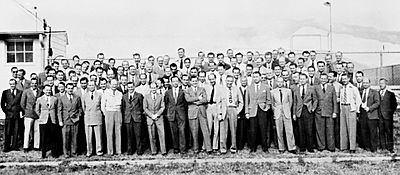Hans Fichtner facts for kids
Quick facts for kids
Hans Fichtner
|
|
|---|---|
| Born | September 8, 1917 |
| Died | October 21, 2012 (aged 95) 7:15 A.M Huntsville hospital
|
| Nationality | German, American |
| Scientific career | |
| Fields | Aeronautics |
| Institutions | Peenemünde Fort Bliss Redstone Arsenal Marshall Space Flight Center |
Hans Joachim Oskar Fichtner (September 8, 1917 – October 21, 2012) was a brilliant rocket scientist. He helped design rockets for space travel and exploration.
He worked with Wernher von Braun in Germany. There, he helped develop the V-2 rockets from 1939 to 1945.
After World War II, Hans Fichtner was one of many scientists who moved to the United States. This happened through a special program called Operation Paperclip. These scientists shared their knowledge about rockets. They first worked at Fort Bliss, Texas, from 1945 to 1949.
Later, Fichtner continued his work with the team at Redstone Arsenal. He then joined the Marshall Space Flight Center to work for NASA.
A Rocket Scientist's Journey
Hans Fichtner played a key role in the early days of rocket science. His work helped shape space travel as we know it.
Designing Rocket Systems
Fichtner was very important in designing the electrical systems for many rockets. These systems made sure rockets could fly correctly and safely.
He helped create the control system for the A4 rocket. He also designed the electrical systems for the V-2 rocket. This included systems for the rocket on the ground and while it was flying.
When he arrived in the United States in 1945, he continued this work. He designed the electrical systems for all the V-2 launches at White Sands in the first year and a half.
Contributions to Space Programs
Hans Fichtner was responsible for the electrical systems of many famous rockets. These included the Redstone, Mercury-Redstone, Jupiter, and Pershing missile.
He was fully in charge of all ground and airborne electrical systems for the Apollo 100 and 200 series missions. This also included all Saturn V rocket launches. After the Apollo project, he worked on the Skylab space station.
Fichtner was also the chief engineer for the High Energy Astronomy Observatory (HEAO) satellite series. These satellites studied space in a new way. He also worked as a consultant for the design of the Spacelab. This was with the ESA in the Netherlands during 1975 and 1976.
He helped bring in new ways to check and launch rockets. He introduced automated, computer-controlled systems during the Saturn/Apollo program. This made rocket launches safer and more efficient.


